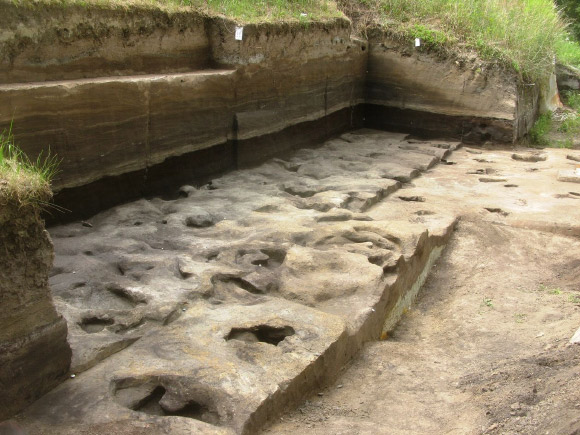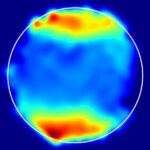Archaeologists have discovered three footprints of Homo heidelbergensis — a direct ancestor of Neanderthals — and numerous footprints of elephants and other species of herbivores at Schöningen, a well-known Middle Pleistocene site on the eastern border of Lower Saxony in northern Germany.
The 300,000-year-old fossil footprints at Schöningen 13 II-2 Untere Berme, Germany. Image credit: Altamura et al., doi: 10.1016/j.quascirev.2023.108094.
“This is what it might have looked like at Schöningen in Lower Saxony 300,000 years ago,” said Dr. Flavio Altamura, a researcher with the Senckenberg Centre for Human Evolution and Palaeoenvironment at the University of Tübingen.
Schöningen yielded a number of localities with archeological and paleontological remains representing a rich paleoenvironmental record of the Middle Pleistocene in northern Europe.
In their new research, Dr. Altamura and his colleagues focused on fossil footprints at two localities: Schöningen 13 I-Fs2 and Schöningen 13 II-2 Untere Berme.
“For the first time, we conducted a detailed investigation of the fossil footprints from two localities in Schöningen,” Dr. Altamura said.
“These tracks, together with information from sedimentological, archaeological, paleontological, and paleobotanical analyses, provide us with insights into the paleoenvironment and the mammals that once lived in this area.”
“Among the prints are three tracks that match hominin footprints, with an age of about 300,000 years.”

This is how it might have looked Schöningen about 300,000 years ago. Image credit: Altamura et al., doi: 10.1016/j.quascirev.2023.108094.
The researchers attributed two of the three hominin footprints to young individuals who used the lake and its resources in a small mixed-age group.
They think that the hominin was a late form of Homo heidelbergensis at the threshold of the transition to the early Neanderthal.
“Depending on the season, plants, fruits, leaves, shoots, and mushrooms were available around the lake,” Dr. Altamura said.
“Our findings confirm that the extinct human species dwelled on lake or river shores with shallow water.”
“This is also known from other Lower and Middle Pleistocene sites with hominin footprints.”
“The various tracks at Schöningen offer a snapshot of a family’s daily life and may provide information about the behavior and social composition of hominin groups as well as spatial interactions and coexistence with elephant herds and other, smaller mammals.”
“Based on the tracks, including those of children and juveniles, this was probably a family outing rather than a group of adult hunters.”
In addition to hominin footprints, the scientists analyzed a series of elephant tracks attributed to the extinct straight-tusked elephant (Palaeoloxodon antiquus).
“The elephant tracks we discovered at Schöningen reach an impressive length of 55 cm,” said Dr. Jordi Serangeli, also from the Senckenberg Centre for Human Evolution and Palaeoenvironment at the University of Tübingen.
“In some cases, we also found wood fragments in the prints that were pushed into the — at that time still soft — soil by the animals.”
“There is also one track from a rhinoceros — Stephanorhinus kirchbergensis or Stephanorhinus hemitoechus — which is the first footprint of either of these Pleistocene species ever found in Europe.”
A paper describing the findings was published in the journal Quaternary Science Reviews.
_____
Flavio Altamura et al. 2023. Fossil footprints at the late Lower Paleolithic site of Schöningen (Germany): A new line of research to reconstruct animal and hominin paleoecology. Quaternary Science Reviews 310: 108094; doi: 10.1016/j.quascirev.2023.108094




